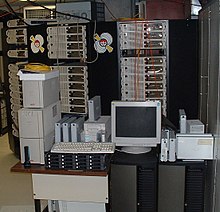This article needs additional citations for verification. (November 2020) |

| External image | |
|---|---|
A Beowulf cluster is a computer cluster of what are normally identical, commodity-grade computers networked into a small local area network with libraries and programs installed which allow processing to be shared among them. The result is a high-performance parallel computing cluster from inexpensive personal computer hardware.
Beowulf originally referred to a specific computer built in 1994 by Thomas Sterling and Donald Becker at NASA.[1] They named it after the Old English epic poem, Beowulf.[2]
No particular piece of software defines a cluster as a Beowulf. Typically only free and open source software is used, both to save cost and to allow customization. Most Beowulf clusters run a Unix-like operating system, such as BSD, Linux, or Solaris. Commonly used parallel processing libraries include Message Passing Interface (MPI) and Parallel Virtual Machine (PVM). Both of these permit the programmer to divide a task among a group of networked computers, and collect the results of processing. Examples of MPI software include Open MPI or MPICH. There are additional MPI implementations available.
Beowulf systems operate worldwide, chiefly in support of scientific computing. Since 2017, every system on the Top500 list of the world's fastest supercomputers has used Beowulf software methods and a Linux operating system. At this level, however, most are by no means just assemblages of commodity hardware; custom design work is often required for the nodes (often blade servers), the networking and the cooling systems.
- ^ Becker, Donald J; Sterling, Thomas; Savarese, Daniel; Dorband, John E; Ranawak, Udaya A; Packer, Charles V (1995). "BEOWULF: A parallel workstation for scientific computation". Proceedings, International Conference on Parallel Processing. 95.
- ^ See Francis Barton Gummere's 1909 translation, reprinted (for example) in Beowulf. Translated by Francis B. Gummere. Hayes Barton Press. 1909. p. 20. ISBN 9781593773700. Retrieved 2014-01-16.[dead link]